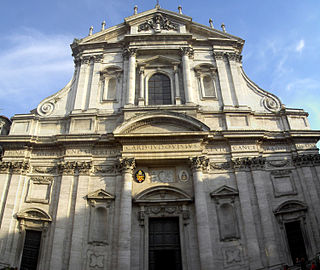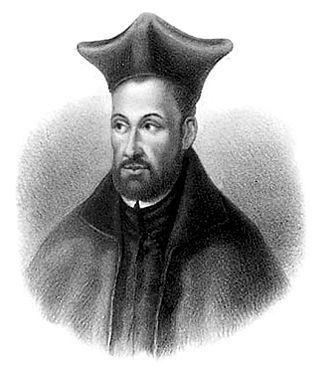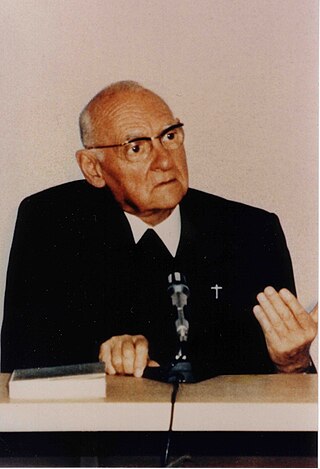External links
Works by John Donne | |||||
|---|---|---|---|---|---|
| Prose | |||||
| Poetry |
| ||||
| Settings to music |
| ||||
Ignatius His Conclave is a 1611 work by 16/17th century metaphysical poet John Donne. The title is an example of "his genitive" and means the conclave of Ignatius. The work satirizes the Jesuits. In the story, St. Ignatius of Loyola, the founder of the Jesuits, is found to be in Hell:
But Ignatius Layola which was got neere his chaire, a subtile fellow, and so indued with the Divell, that he was able to tempt, and not onely that, but (as they say) even to possesse the Divell, apprehended this perplexity in Lucifer. [1]
Ignatius is subsequently ejected from Hell and ordered to colonize the moon where he will do less harm.
The text mocks Jesuit evangelism and makes references to many scientists of the day, including Copernicus, Kepler, Brahe, and Galileo. [2] Marjorie Hope Nicolson sees Ignatius as derived from Johannes Kepler's Somnium [3]
{{cite web}}: CS1 maint: bot: original URL status unknown (link)
Francis Xavier, SJ, venerated as Saint Francis Xavier, was a Spanish Catholic missionary and saint who was a co-founder of the Society of Jesus.

John Donne was an English poet, scholar, soldier and secretary born into a recusant family, who later became a cleric in the Church of England. Under royal patronage, he was made Dean of St Paul's Cathedral in London (1621–1631). He is considered the preeminent representative of the metaphysical poets. His poetical works are noted for their metaphorical and sensual style and include sonnets, love poems, religious poems, Latin translations, epigrams, elegies, songs and satires. He is also known for his sermons.

The Society of Jesus, commonly known as the Jesuits, is a religious order of clerics regular of pontifical right for men in the Catholic Church headquartered in Rome. It was founded in 1540 by Ignatius of Loyola and six companions, with the approval of Pope Paul III. The society is engaged in evangelization and apostolic ministry in 112 nations. Jesuits work in education, research, and cultural pursuits. Jesuits also conduct retreats, minister in hospitals and parishes, sponsor direct social and humanitarian ministries, and promote ecumenical dialogue.

Pope Urban VIII, born Maffeo Vincenzo Barberini, was head of the Catholic Church and ruler of the Papal States from 6 August 1623 to his death in July 1644. As pope, he expanded the papal territory by force of arms and advantageous politicking, and was also a prominent patron of the arts and a reformer of Church missions.

The Church of St. Ignatius of Loyola at Campus Martius is a Roman Catholic titular church, of deaconry rank, dedicated to Ignatius of Loyola, the founder of the Society of Jesus, located in Rome, Italy. Built in Baroque style between 1626 and 1650, the church functioned originally as the chapel of the adjacent Roman College, which moved in 1584 to a new larger building and was renamed the Pontifical Gregorian University.

Peter Faber, SJ was a Jesuit priest and theologian, who was also a co-founder of the Society of Jesus, along with Ignatius of Loyola and Francis Xavier. Pope Francis announced his canonization in 2013.
Malachi Brendan Martin, also known under the pseudonym of Michael Serafian, was an Irish-born American Traditionalist Catholic priest, biblical archaeologist, exorcist, palaeographer, professor, and prolific writer on the Roman Catholic Church.

Saint Ignatius College Prep is a selective private, coeducational Jesuit college-preparatory school located in the Near West Side neighborhood of Chicago, Illinois. The school was founded in Chicago in 1869 by Fr. Arnold Damen, S.J., a Dutch missionary to the United States.

Julius Riyadi Cardinal Darmaatmadja is an Indonesian cardinal of the Roman Catholic Church. He was created a cardinal in 1994, becoming the second Indonesian to be a cardinal. He served as the Archbishop of Semarang from 1983 to 1996 and Archbishop of Jakarta from 1996 to 2010.

Henri-Marie Joseph Sonier de Lubac, better known as Henri de Lubac, was a French Jesuit priest and cardinal who is considered one of the most influential theologians of the 20th century. His writings and doctrinal research played a key role in shaping the Second Vatican Council.

Hans Urs von Balthasar was a Swiss theologian and Catholic priest who is considered an important Catholic theologian of the 20th century. Pope John Paul II announced his choice of Balthasar to become a cardinal, but he died shortly before the consistory. Cardinal Joseph Ratzinger said in his funeral oration for Balthasar that "he is right in what he teaches of the faith" and that he "points the way to the sources of living water".

Saint Ignatius' College Riverview is an Australian independent single-sex primary and secondary day and boarding school for boys located in Riverview, a small suburb located on the Lane Cove River on the Lower North Shore of Sydney, New South Wales.

Timothy Stafford Healy was an American Catholic priest and Jesuit who straddled the religious and secular life, serving as the vice chancellor of the City University of New York, the president of Georgetown University, and the president of the New York Public Library.

John de Lugo (1583–1660), a Spanish Jesuit and Cardinal, was an eminent theologian of the Baroque.

Mar Ignatius Gabriel I Tappouni was a leading prelate of the Syriac Catholic Church. He served as Patriarch of Antioch from 1929 to 1968, and was elevated to the cardinalate in 1935.

The Holy Sonnets—also known as the Divine Meditations or Divine Sonnets—are a series of nineteen poems by the English poet John Donne (1572–1631). The sonnets were first published in 1633—two years after Donne's death. They are written predominantly in the style and form prescribed by Renaissance Italian poet Petrarch (1304–1374) in which the sonnet consisted of two quatrains and a sestet. However, several rhythmic and structural patterns as well as the inclusion of couplets are elements influenced by the sonnet form developed by English poet and playwright William Shakespeare (1564–1616).

The 1769 papal conclave, was convoked after the death of Pope Clement XIII. It elected as his successor Cardinal Lorenzo Ganganelli, who took the name Clement XIV.
Nationality words link to articles with information on the nation's poetry or literature.

Ignatius of Loyola, venerated as Saint Ignatius of Loyola, was a Spanish Catholic priest and theologian, who, with Peter Faber and Francis Xavier, founded the religious order of the Society of Jesus, and became its first Superior General, in Paris in 1541. He envisioned the purpose of the Society of Jesus to be missionary work and teaching. In addition to the vows of chastity, obedience and poverty of other religious orders in the church, Loyola instituted a fourth vow for Jesuits of obedience to the Pope, to engage in projects ordained by the pontiff. Jesuits were instrumental in leading the Counter-Reformation.
Ignatian spirituality, similar in most aspects to, but distinct from Jesuit spirituality, is a Catholic spirituality founded on the experiences of the 16th-century Spanish Saint Ignatius of Loyola, founder of the Jesuit order. The main idea of this form of spirituality comes from Ignatius's Spiritual Exercises, the aim of which is to help one "conquer oneself and to regulate one's life in such a way that no decision is made under the influence of any inordinate attachment." The Exercises are intended to give the person undertaking them a greater degree of freedom from his or her own likes and dislikes, so that their choices are based solely on what they discern God's will is for them. Even in the composition of the exercises by Ignatius early in his career, one might find the apostolic thrust of his spirituality in his contemplation on "The Call of the Earthly King" and in his final contemplation with its focus on finding God in all things.